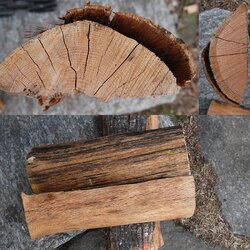I got a lot of wood, some of it oak, last Jan-March, (I volunteered with a nature group to open up savanna, and they give the wood away) and it's been sitting stacked on concrete for a year. I covered it with plastic in December, some just on the top, some covering the sides too. Everything is 4-10" diameter, and it's 18-26 inches long.
Today I started working on that stuff, in part hoping it would be seasoned enough to burn now. I was cutting stuff to fit the stove, and/or splitting it. The wood looked wet, and my digital moisture meter had readings of 25-35%. ^*&%&^$!! Oak that's been sitting for one year, mostly cut to length, still has that much moisture??
There were some other hardwoods that were around 25% moisture too, so it wasn't just the oak. I think the wood was probably cut after the sap rose, I know at least some of it was cut as the trees were leafing out. Would January-cut wood have had the sap up, too? I didn't have a moisture meter back when I got it, so I don't know what the reading was when it was freshly-cut.
Is the darn stuff going to be ready to burn this year?? Do I need to build a wood kiln? (Wood that the meter says is 19-20% moisture doesn't do well in my stove, unless it's mixed with dry stuff)
Today I started working on that stuff, in part hoping it would be seasoned enough to burn now. I was cutting stuff to fit the stove, and/or splitting it. The wood looked wet, and my digital moisture meter had readings of 25-35%. ^*&%&^$!! Oak that's been sitting for one year, mostly cut to length, still has that much moisture??
There were some other hardwoods that were around 25% moisture too, so it wasn't just the oak. I think the wood was probably cut after the sap rose, I know at least some of it was cut as the trees were leafing out. Would January-cut wood have had the sap up, too? I didn't have a moisture meter back when I got it, so I don't know what the reading was when it was freshly-cut.
Is the darn stuff going to be ready to burn this year?? Do I need to build a wood kiln? (Wood that the meter says is 19-20% moisture doesn't do well in my stove, unless it's mixed with dry stuff)



